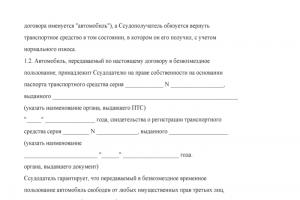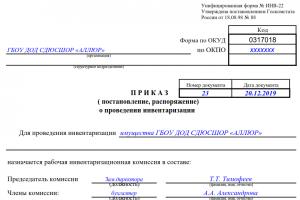by discipline macroeconomics
option: 3 (questions No. 9, 39, 13, 42, 55, 5, 64, 65)
Supervisor
A.A. Khapikov
(academic degree, title) (signature) (initials, surname)
Moscow – 2007
Current unemployment is cyclical unemployment.
Cyclical unemployment represents deviations of the actual unemployment rate (u) from the natural unemployment rate (u*) associated with short-term fluctuations in economic activity. Cyclical unemployment is unemployment caused by a recession (downturn) in the economy, when actual GDP is less than potential. This means that the economy is underemployed and the actual unemployment rate is higher than the natural one.
When a situation of full employment has been achieved, which corresponds to 95 - 96% of the labor force, the country's actual GDP will be equal to its potential GDP. This means that all resources will be fully utilized. If full employment is not achieved (all jobs are not occupied), then even in the complete absence of any type of unemployment, actual GDP will not reach the potential level. And the actual unemployment rate is the natural level.
Full employment in the economy means that the actual unemployment rate is equal to its natural rate, that is, all jobs are occupied,
Full employment does not mean the absolute absence of unemployment. Economists consider frictional and structural unemployment to be completely inevitable: hence, "full employment" is defined as employment that accounts for less than 100% of the labor force. Precisely speaking, full employment unemployment rate equal to the sum of the levels of frictional and structural unemployment. In other words, the full employment unemployment rate is reached when when cyclical unemployment is zero. The full employment unemployment rate is also called natural rate of unemployment
The question of the monetary measurement of GDP. Being cost indicator, GDP depends on the level and structure of prices in which the goods included in it are measured. In this regard, a distinction is made between nominal and real gross domestic product.
Nominal GDP is the gross domestic product calculated in real (current) prices of a certain period:
Where ![]() - nominal GDP;
- nominal GDP;
Quantity of the i-th product (or service),
produced in the country during a given period.
The value of nominal GDP is greatly influenced by inflationary processes. It is enough for prices to rise for it to also rise.
To eliminate inflationary effects, real gross domestic product (also called gross domestic product at constant prices) is calculated. To do this, manufactured products are expressed in prices of a certain (called base) year:
External debt is the debt of the state to foreign citizens, firms and institutions.
Curve AnalysisIS-LM- a method developed by J. Hicks and A. Hansen for studying the conditions of simultaneous equilibrium on goods market And money market in the country. IS curve (I-investment, investments, S - savings, saving) reflects equilibrium in the goods market: the more saved, the more investment (and therefore production), but the lower demand on goods because consumers have less money. True, recently, due to the improvement models, here we consider, on the one hand, the level real interest r, with another - national income Y, but the name of the model itself has traditionally been preserved. The IS curve shows that if the real interest rate rises,

Fig.A.3 IS and LM curves
LM curve (short for liquidity demand, demand for liquid assets, i.e. demand for money, and money supply, money offer) reflects, accordingly, possible combinations of demand and supply of money that ensure equilibrium in the money market. At each point, the demand for money, determined by the level of the real interest rate R, is equal to the given exogenously(under the influence of the state's monetary policy) to the supply of money.
Thus, the intersection of the IS and LM curves placed on one graph, where the abscissa is the volume of production, the volume of national income Y, and the ordinate is the real interest rate R, identifies the point of macroeconomic equilibrium as a result of the conditions prevailing in both the commodity and money markets. This relationship is extremely simplified, because it does not take into account the internal reasons for the creation of such conditions, as well as the probabilistic nature of the monetary system.
The “labor force” category includes people who can work, want to work, and are actively looking for work. Those. these are people who are either already employed in social production or who do not have a job, but are making special efforts to find it. Thus, the total workforce is divided into two parts:
busy(employed - E) - i.e. having a job, it doesn’t matter if the person is busy
full-time or part-time, full-time or part-time. A person is also considered busy if he does not work for the following reasons: a) is on vacation; b) is sick; c) on strike and d) due to bad weather;
unemployed(unemployed - U) - i.e. not having a job, but actively her
seekers. Job search is main criterion, distinguishing the unemployed from people not included in the labor force.
Thus, the total workforce is: L=E+U .
(At the same time, military personnel on active military service, although formally classified as employed, are, as a rule, not taken into account in the total labor force when calculating the unemployment rate. This indicator is usually (unless specifically stated) calculated only for the civilian sector of the economy .)
Indicators of the number of employed and unemployed, the size of the labor force and the number of those not included in the labor force are indicators of flows. There are constant movements between the categories of “employed”, “unemployed” and “not included in the labor force” (Fig. 7.1.). Some of the employed lose their jobs, becoming unemployed. A certain proportion of the unemployed find work by becoming employed. Some of the employed quit their jobs and leave the public sector of the economy (for example, by retiring or becoming a housewife), and some of the unemployed, in despair, stop looking for work, which increases the number of those not included in the labor force. At the same time, some people who are not involved in social production begin an active search for work (unemployed women; students who have graduated from higher educational institutions; tramps who have come to their senses). Typically, in a stable economy, the number of people losing their jobs is equal to the number of people actively looking for one.
The main indicator of unemployment is the unemployment rate. Unemployment rate(rate of unemployment - u) represents attitude number unemployed To general number working strength(the sum of the number of employed and unemployed), expressed as a percentage:
 or
or 
Frictional unemployment(from the word “friction” - friction) is associated with job search. Obviously, finding a job takes time and effort, so a person waiting or looking for a job is unemployed for some time. A feature of frictional unemployment is that people are already looking for work ready-made specialists with a certain level of professional training and qualifications. Therefore, the main reason for this type of unemployment is imperfect information(information about the availability of vacancies). A person who loses his job today usually cannot find another job tomorrow.
Frictional unemployed include:
dismissed from work by order of the administration;
those who resigned of their own free will;
awaiting reinstatement to their previous job;
those who have found a job but have not yet started it;
seasonal workers (out of season);
people who have entered the labor market for the first time and have the level of professional training and qualifications required in the economy.
Frictional unemployment is not only a phenomenon inevitable, since it is associated with natural trends in the movement of the labor force (people will always change jobs, trying to find a job that best suits their preferences and qualifications), but also desirable, as it contributes to a more rational allocation of labor and higher productivity (favorite work is always more productive and creative than the one that a person forces himself to do). The level of frictional unemployment is equal to the ratio of the number of frictional unemployed to the total labor force expressed as a percentage:  .
.
|
Which of the following points corresponds to the neoclassical point of view on the AD-AS model: |
AD is determined by the volume of national product |
|
|
Prices and wages are inelastic |
||
|
The volume of savings and investments is determined by various economic entities, which are guided by their own motives and interests |
||
|
Equilibrium may occur when factors of production are underemployed |
||
|
The economy always operates at full employment of production factors |
One of the most important patterns in the functioning of a capitalist market economy is macroeconomic instability, manifested in periodic fluctuations in total production, employment (unemployment) and the price level. Unemployment and inflation, being among the most important macroeconomic problems, are the most striking manifestations of macroeconomic instability. At the same time, both unemployment and inflation have a strong impact on the socio-economic development of society as a whole, being the object not only of close attention of academic economists, but also of state macroeconomic policy.
Economic cycles. Potential and actual GDP. Causes of economic fluctuations. Phases of the cycle.
Theories of cyclical development.
Unemployment and its forms. Measuring unemployment.
Natural rate of unemployment. Okun's Law.
Inflation and its measurement. Inflation rate.
Demand inflation and cost inflation.
Inflation and real income. The impact of inflation on the redistribution of income and wealth. The influence of inflation on the volume of national production.
Stabilization policy and its methods.
1. Economic cycles. Potential and actual GDP. Causes of economic fluctuations.
Economic cycles. Potential and actual GDP.
Economic cycle represents periodically recurring and successive ups and downs of economic activity against the background of the general trend of economic growth.
Figure 4.1 shows a possible picture of the cycle. We plot years on the abscissa axis. On the ordinate axis – volume GDP as the most general indicator of economic activity. The straight line depicts the trend of economic growth (trend), that is, it represents the dynamics of volume potential GDP in time. The wavy line depicts the actual cyclical development of the economy, that is, it represents the time dynamics of the volume actual GDP (in nominal terms).
Potential GDP - the maximum volume of real output that an economy is capable of producing over a given period of time (usually a year) with the full and efficient use of all available factors of production and available technology.
Potential GDP, therefore, determines the production potential of the economy and depends on the volume of the total labor force and labor productivity. (More about this in the topic “Economic Growth”).
Actual GDP – the volume of real output created in the economy over a certain period.
Level actual GDP determined by the interaction of aggregate demand and potential GDP . If the level of aggregate demand is less than potential GDP, then the level of actual GDP will be below potential GDP, since it will be equal to the level of aggregate demand. When aggregate demand increases, actual GDP can reach the level of potential GDP, but by definition cannot be higher than it (Figure 4.1A).
GDP actual potential GDP
GDP (nominal)
 GDP
GDP
potential GDP
actual GDP
In Figure 4.1 the actual GDP presented in nominal terms: upward deviations of the wavy line from the trend indicate inflation.
Causes of economic fluctuations.
The economic cycle first manifested itself in England, where in 1825 the first crisis of overproduction was noted (as the economic cycle was then called). recession or recession). Since then, this phenomenon has been repeated periodically every 7-12 years. Since 1857, the cycle has become global in nature, since this year the economic downturn (recession) hit all the most developed countries. The deepest recession in capitalist countries took place in 1929-1933 and went down in history as « The Great Depression » : the decline in production reached 40% in some countries.
The scientific theory of cyclical development was developed by K. Marx in “Capital” on the basis of the labor theory of value. The classics and neoclassics did not recognize the natural nature of cyclical development. They believed (many of their followers still believe) that recessions are caused by exogenous (that is, external to the economy) factors: wars, revolutions, but mainly by incorrect monetary policy of the state.
Since the time of Keynes, the view has been established that cause economic downturns are rooted in insufficient aggregate in demand. Respectively cause of macroeconomic fluctuations(that is, the existence of a cycle), according to most modern economists, are fluctuations in aggregate demand, especially investment demand.
Read also:
|
Aggregate supply - the total quantity of goods and services produced in the economy
The aggregate supply (AS) curve shows how much aggregate output can be supplied by producers at different values of the general price level. There are three segments of the curve (AS):
1. Horizontal. At constant prices, changes occur in the volume of national production.
2. Ascending. The rise in prices is accompanied by an increase in national production volumes.
3. Vertical. GNP remains unchanged, but only prices rise.
The coordinate axes indicate the aggregate price level (P) and aggregate income or aggregate output (Y).
Supply reflects changes in the volume of aggregate supply, moving along this curve, depending on price movements. Non-price factors also contribute to a shift of the aggregate supply curve to the left (AS2) or to the right (AS1). Non-price factors include changes in technology, resource prices, level of taxation, etc.
There is also a short-term and long-term time period, which have a strong impact on the aggregate demand curve. The differences between them are associated mainly with the behavior of the nominal and real values of the variables. The nominal value acts as wages, price, interest rate, etc. The real value acts as the volume of output, the real interest rate, the level of employment, etc. In the short term, the nominal value changes very slowly, and the real value, on the contrary, changes very quickly. In the long run, everything happens the other way around: real ones change slowly, and nominal ones change quickly. Therefore, based on this, we can depict the short-term curve and the long-term aggregate supply curve
Non-price factors of aggregate supply[edit | edit source text]
1. Price level for production resources.
2. Market structure.
3. Productivity.
4. Changes in legal regulations
Also, some factors listed below influence the amount of aggregate supply:
1 Prices for resources. When they increase, production costs increase and, as a result, there is a decrease in aggregate supply.
Potential GDP is the internal product of the state, which can be provided to the maximum extent with full use of available resources.
This state is called. There is another concept - real GDP, for the formation of which producers create and sell the required amount of products over a certain time at different price levels. When analyzing, it is customary to distinguish long-term and short-term periods. Thus, subjects in the long term can be described by a classical model. A free market without government intervention automatically ensures the use of resources in production, which leads to the achievement of potential GDP.
The size of potential GDP is determined depending on the size of available technologies and resources, but may not depend on That is why the long-term aggregate supply curve is vertical.

Potential GDP obeys the law of neutrality of money. Thus, the vertical direction of the curve indicates the degree to which output at the level of such GDP is supported by the forces of the market and competition in the long term. At the same time, the price level can have different values and depend on the volume of funds in the economy. And the other side of this economic law is that in the presence of high prices, high prices are traced, and in long-term planning it affects both prices and
As the amount of resources in the economy increases, the development of technical progress can be traced and, accordingly, potential GDP increases, and its curve on the graph should shift to the right. But with a reduction in resources or technical regression, everything should happen the other way around.

A significant number of economists believe that GDP (actual and potential) can reflect the long-term period in macroeconomics. At the same time, deviations of the first type of internal product from the second are quite successfully eliminated by the market.
However, modern economists have concluded that there is a short period (an example is a quarter) in which the classical approach to the neutrality of money cannot work. In other words, any changes in the money supply have a significant impact on both the price level and potential GDP. Thanks to this statement, a new concept has emerged - short-term GDP, to reflect the dynamics of which the aggregate supply curve is no longer vertical, but rather horizontal.
Such a curve reflects the possibility of increasing the ability of business entities to produce products at a certain price level. This fact is confirmed by the presence of noticeable gaps between actual GDP and its potential level. In other words, the domestic economy is not operating at full capacity.
Potential GDP- the maximum volume of real output that an economy is capable of producing over a given period of time (usually a year) with the full and efficient use of all available factors of production and available technology. From the notebook, this is GDP produced with full efficient use of resources.
Actual GDP– the volume of real output created in the economy over a certain period.
Uk.r.=Ufakt.-U*(market gap in GDP production, GDP losses)
Okun's law (law of the natural rate of unemployment) - if the actual unemployment rate exceeds the natural rate by 1%, the lag of actual GDP from potential is 2-2.5%.
The Okun parameter reflects the sensitivity of GDP to the value of market unemployment.
Ufact.-U*/ U* *100% = -y*(Ufact.-U*)
If employment falls and unemployment rises, output will also fall. Thus, the graph reflects the decreasing dependence of output on the unemployment rate.
12. Inflation: concept and types.
Inflation- in macro: a sustainable process of increasing the general price level.
Inflation- this is the process of depreciation of money, which manifests itself in an increase in prices for goods and services, not due to an increase in their quality. An increase in the price level, inflation, means a decrease in the purchasing power of money.
The causes of inflation are divided into internal and external.
To internal reasons include:
State budget deficit associated with increased government spending;
High level of unproductive government spending, especially military;
Disproportions at the level of micro- and macroeconomics, which are a manifestation of the cyclical nature of economic development;
Mistakes in the government's economic policy and others.
External reasons inflation are:
Structural global crises (raw materials, energy, food, etc.), which are accompanied by multiple increases in prices for raw materials, oil, food, etc. This growth became the reason for a sharp increase in prices for monopolies for their products;
The exchange of national currency by banks for foreign currency causes the need for additional issue of paper money, which overwhelms the channels of monetary circulation and leads to inflation.
Deflation- a sustainable process of reducing the general price level. Disinflation is a decrease in the rate of growth of the price level. Stagflation – stagnation + inflation (a combination of unemployment and inflation).
An inflation shock is a sudden increase in the general price level.
Moderate (creeping) inflation is characterized by an increase in consumer prices of about 10 percent per year.
Galloping inflation is a phenomenon in which there is a serious rise in prices and a decline in the country's economy.
Hyperinflation is an extremely rapid increase in the general level of prices of goods and services.
13. Measuring inflation: indicators of price levels and inflation rates.
A system of indicators reflecting the growth of the price level in the macroeconomy: 1) GDP deflator index2) consumer price index (to estimate the cost of living)
Deflator calculated for a changing set of goods; it shows changes in prices for the entire list of products and services produced in the economy; it takes into account changes in the structure of goods produced; it shows changes in prices for products produced by national factors. In other words: The GDP deflator takes into account the prices of all goods and services produced in a country. The deflator does not take into account the prices of imported goods. The deflator allows for changes in the mix of goods and services in accordance with changes in the composition of GDP.
2)CPI calculated on the basis of the consumer basket - a set of goods and services reflecting the consumption structure of a typical family (from 300 to 600 goods in different countries, in the Russian Federation = 495).
CPI= sum p1*q0: sum p0*q0
The composition of the basket is determined by experts and has been used to measure the CPI for many years.
CPI= cost of the consumption basket in prices of the current year: cost of the consumption basket in prices of the base year
3)𝝅 - inflation rate - rate of increase in the price level (rate of increase in the price level)
𝝅=CPI1-CPI0/CPI0 *100%
Over the past two decades, the Central Banks of many countries have been pursuing an inflation targeting policy - setting inflation targets. 𝝅for developed countries=2% per year, 𝝅2017/2018=4% per year
4) Nominal income is understood as the actual income received by an economic agent in the form of wages, profits, interest, rent, etc. Real income is determined by the number of goods and services that can be purchased with the amount of nominal income. Thus, to obtain the value of real income, it is necessary to divide nominal income by the price index:
Real Income = Nominal Income / Consumer Price Index







